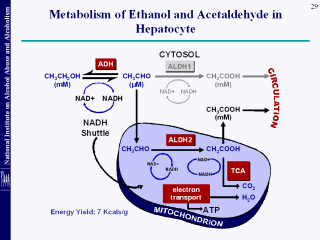The major pathway for the metabolism
of alcohol is found in the liver and involves the enzyme alcohol
dehydrogenase (ADH). Alcohol is metabolized to acetaldehyde, a
highly reactive and potentially toxic molecule. In most
circumstances, acetaldehyde is rapidly metabolized by another
enzyme, aldehyde dehydrogenase (ALDH) to acetate. Because of the
rapid enzymatic conversion of acetaldehyde to acetate, the
concentration of acetaldehyde in the cell is typically a
thousand-fold lower than that of alcohol, and the eventual product
of this pathway, acetate. Both alcohol and acetate are found at
millimolar levels following drinking, while acetaldehyde is found at
micromolar concentrations. [The legal intoxicating blood alcohol
level in all states in the U.S. is 80 mg%, which is 17.4 mM. The
normal baseline level for acetaldehyde in humans is 9 µM, or 40
µgram%. After alcohol ingestion, the acetaldehyde level in most
individuals will increase to 20-30 µM, or 90 – 130 µgram%.
Metabolism of a dose of alcohol achieving a blood alcohol
concentration of 80 mg% may result in elevation of tissue acetate
levels by 100 mg%.] When the level of acetaldehyde increases, an
individual may experience very dysphoric feelings and the potential
for toxic reactions with various cellular components increases.
